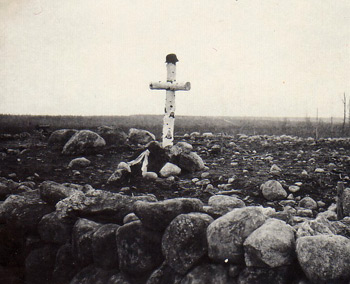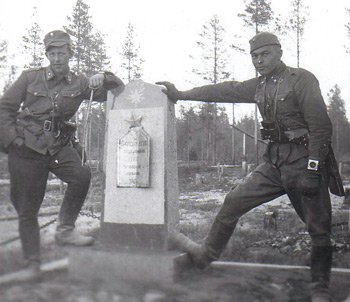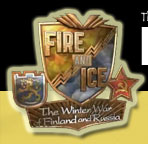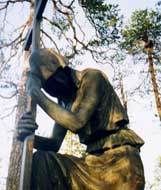

Policies of Finland and the Soviet Union in honoring the dead differed greatly.
The Finnish Army tried its best to evacuate the fallen men from the battlefield and give men a proper funeral in the home parish of a fallen soldier. In every Finnish churchyard a special section of the cemetery was allocated for men killed in wars (a war hero cemetery).
Finnish soldiers carried dog tags that were similar to German tags. The oval-shaped dog tag had the soldier’s unique identification number on the lower and the upper parts of it. There were small holes in the middle, so the two parts could be separated easily. If a soldier was killed, the death tag would be broken by medics or comrades of the fallen soldier. One part was to stay with the body, while the second was presented to officers as a proof of a soldier being killed.
However, a battle situation is often a chaotic place influenced by a host of different factors beyond control of a single soldier. In many bitter battles Finnish soldiers could not evacuate the bodies of their fallen comrades from the battlefield. The worst places were Summa, the Gulf of Vyborg and the wilderness of Karelia in the north.
In 1941-1942, many Finnish parishes and Home Guards, as well as the army, organized search expeditions to recover the remains of the dead from the battlefields. Those men who could still be identified, were taken back to their home parishes and buried there. Those, whose remains could no longer be identified, were buried in hero graves on the battlefields.

Finnish field cemetery in Taipale in April 1943.
Bair
Irincheev
The search expeditions were varying in scale and quality of work. Remains of fallen Finnish soldiers are still being found on the battlefields of the Winter War. Some men were buried alive by explosions; some were blown into pieces by direct hits of artillery and only a handfull of bones and a dog tag are found. Some were buried by the Red Army burial detachments in mass graves together with Red Army men.
Such remains are handed over to the Finnish officials and then undergo DNA tests in laboratories of Helsinki Universiry. Surviving relatives of fallen soldiers are only informed of finding when Finnish officials are 100 percent sure that the remains belong to the person whose dog tag was found on the bones.
The Red Army of 1930s also had dog tags. They were different from Finnish tags. They were either small flat metallic boxes with a piece of paper in it with the name and all personal information written on it, or a bakelite lipstick-shaped box with a similar piece of paper. On the piece of paper a soldier was supposed to write his full name, date of birth and home address. Reality was much different from theory, though. Many Red Army men had a superstition that if they filled out the paper, they would be killed in battle for sure. For the same reason, men often threw away their dog tags.
In December 1939 and January 1940, many fallen Red Army men were lying on the Finnish-controlled soil or in no-man’s land. These bodies could not be evacuated from the battlefield without serious risk for the burial units. Many battlefields continued to be pounded by artillery, so remains of fallen men, Finnish obstacles and dirt were all blown into pieces and mixed in the mud.
Even on Red Army-controlled territory men were not always buried, as veterans recalled. In April 1940, when Stalin held a seminar in the Kremlin with all of the Red Army commanders that took part in the Winter War, Stalin sharply criticized the officers that did not bury their men.
According to Russian Army traditions, Red Army men were buried on the battlefields in mass graves (a grave of brothers, as it was called in Russian). Honoring the dead varied greatly depending on a unit and unit’s commander. Those who were buried in mass graves had their grave marked with a modest monument made of wood, cardboard or grave stones taken from nearby Finnish cemeteries. These monuments were small and weak. The work of making new monuments was not complete when the Finnish Army struck back in 1941, and recaptured the Karelian Isthmus. Larger monuments were only built next to highways. Mass graves in the forests were still small wooden ones. When the Finnish Army came, some of these graves were still visible. Finns neither destroyed nor maintained the graves, so in 1944, when the Red Army recaptured the Karelian Isthmus, markings on most of these graves were gone.

Finnish officers and soldiers posing at a Russian
field cemetery in 1941, when Finland stroke back at the Soviet Union
and recaptured the Karelian Isthmus.
Bair Irincheev
In the memory of the Soviet people the Winter War was overshadowed by the Great Patriotic War against Germany that cost the Soviet Union about 27 million lives. The Winter War and its fallen men were to some extent forgotten both by the state and the people.
In the 1970s, the Soviet government encouraged people to form voluntary search parties to find remains of fallen Soviet soldiers of World War II still lying on the battlefields or in unidentified graves. These search parties received some funding and assistance from the government. In the 1990s, with the end of Soviet period of Russian history, this tradition continued. Almost every summer remains of Red Army and Finnish soldiers are found on the battlefields of the Winter War. Fallen Finnish men are handed over to the Finnish officials, while Red Army men are buried in field cemeteries across the Karelian Isthmus. The main Russian field cemeteries are in Summa and in Taipale.
The latest funeral ceremony in Summa was held in December 2005, when remains of 130 Red Army men and commanders were laid to rest. Most of the men were found in an unmarked grave in the forests next to Mannerheim Line between Summa and Leipäsuo sectors.
It is important to mention that in addition to fully licensed and registered search parties there are plenty of unofficial battlefield archaeologists. These men are interested in finding relics from the war (helmets, canteens, old weapons and ammo, etc) and care little for remains of the fallen. However, in many cases the unofficial archaeologists strip remains of fallen men of all valuable belongings and then inform the official search parties where to pick up the remains. In some cases members of official search parties go hunting battlefield for relics without proper permissions from the local municipality.
So, for some men it is a moral duty to find and give a proper funeral for fallen Russians and Finns For other men, the battlefields of Winter War are just a place to hunt battlefield relics.





